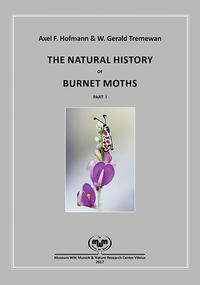
Foreword One of the great conundrums of humanity is that we lay waste the life treasures on our own planet whilst ardently seeking new life on others. The harsh truth of it is that our greed to exploit exceeds our inclination to protect; in too few human beings do pure curiosity and respect of other creatures outweigh more selfish motives. The blessing is that such special people do exist, they are the very best of humankind; we have two of these rare individuals in Axel Hofmann and Gerry Tremewan, the authors of this wonderful three volume monograph on burnet moths. Search the planet high and low, you will find little to compare with the outstanding beauty of burnets that, active in sunshine, in every way match, outshine even, the fragile delights of butterflies. In German, they are Blutströpfchen, ‘blood drops’, after the markings on the wings; increasingly, the molten-magma red spots of these wonderful creatures impresses on us the planet’s own human-induced surface wounds. But there is more to them than sheer beauty; their study has revealed so much of the engine of evolution, how the living world is integrated and functions, expanding a sense of rationality and objectivity in us, enhancing our understanding and pleasure of our world during our all too brief stay on it. This monograph is based on dedicated work, consuming two lifetimes, and to have achieved it Axel and Gerry have had to be both explorers and scientists: to have been one is exceptional, to have been both is a rare distinction. Owing to internecine conflicts burnets, currently, occupy some of the most dangerous places on Earth and yet, undaunted (when setting out on such journeys, their excitement erasing concern), the study of these enthralling creatures has drawn these two men to seek out nature’s secrets in the most precarious, but exquisite, places and to return to enhance our lives with their discoveries. For all the dangers, this study could not have been more timely, as the Earth’s biomes and biotopes – habitats – on which these and many other creatures depend are fast dissolving into oblivion under man’s insatiable industry. Faced with uncomprehending hostility to exploration, and owing to our collective failure to revere what we have inherited, it will not be possible, ever again, to repeat many of these ventures into the world of burnets and still find them there. It is an immense honour to have been asked to write this foreword and it is unlikely that my words carry the weight of my feelings, of sheer admiration and delight, for this achievement. This work is simply immense in the vast spread of cover, of species and higher taxa in space and time, and in the depth of study from biological minutiae revealed in the laboratory to the fascinating associations and affinities of each species in the field. The objective of the authors is holism, completeness, on the biology of burnets; their modus operandi is to have questioned everything, to have taken nothing previously recorded for granted and these are exceptional virtues for the next generation to follow. The clarity and brilliance of illustration, from microscopic traits to landscapes, are unsurpassed and alone give immense pleasure. The reader will be astonished by the detail and complexity, for example, from the fine details of oxalate crystallites in the cocoons to the reconstructed pathways of phylogeography. This work is borne of individuals with immense patience and perseverance. Breeding moths from this group to reveal life history is no simple matter; to have successfully run broods through many generations to extract crosses thereby to expose the genetics of colour and pattern, and speciation, is quite remarkable. That process, in itself, those discoveries, should receive our lasting homage. Building science arises from the long careful accumulation of facts; Gerry and Axel have already published seminal works on this extraordinary taxon and this is the culmination of many papers, many journeys, an extraordinary joint achievement built on loyal, honest and unselfish scientific comradeship, integrity, and respect for the natural world. That, too, is an important lesson for the next generation. The joy of travelling to far-off burnet landscapes, and the ability to understand them, is a gift given to few. Axel and Gerry have brought them to you. Enjoy them and learn to treasure what you see; honour these men who have done this for you and your descendants. For my part, and fieldwork finished long ago, I recall with lasting delight, in my youth, finding the papery pupal crescents high on grass stems for the first time and watching the adult moth feel its way into a soft summer day. There is no butterfly – let alone moth – to match them, these untroubled, languid residents of hillside and meadow. They alone have that striking but fatal beauty that allows them, seemingly unperturbed, to cling exposed to flowers, often clustered, there to mate, to feed, to rest, to sleep; even humans may be allowed to approach and admire these gems of creation. When I do so I shall be mindful of these two men who know them best of all, and I feel sure that any reader will do so too. Professor Dr Dr Roger L. H. Dennis 30 April 2016